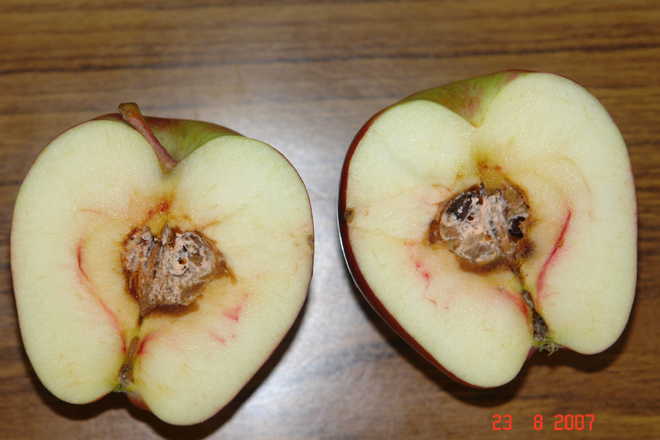Ambika Sharma
Tribune News Service
Solan, April 1
In a bid to manage the apple core rot disease, which causes 30 to 40 per cent loss of production, scientists of Dr YS Parmar University of Horticulture and Forestry, Nauni, have suggested pruning and training of apple trees to allow proper sunlight and air to reach every part of the tree.
The scientists said every year this disease resulted in economic loss of Rs 720 million to the state. Affected fruits initially do not produce any signs and symptoms as the pathogen remains incipient in the seed core of the fruit, however, such fruits have a bitter taste when eaten.
In order to curb its incidence, the scientists have suggested a slew of measures which include spray of mancozeb (600g) or zineb (600 g) per 200 litres of water at the pink bud stage. In addition, orchards having high incidence history of core rot, sprays of difenoconazole (30 ml) or hexaconazole (100 ml) per 200 litres of water are generally recommended for the management of apple scab and powdery mildew at the petal-fall stage explained Dr AK Gupta, Professor and Head, Department of Plant Pathology.
“Since apple is the mainstay of the state’s economy, which contributes in a big way to the GDP, the emergence of core rot of apple has become a major constraint in apple production as it affects almost every orchard of the state that results in loss of 30 to 40 per cent of the production” explained Gupta.
These fruits are also unsafe for consumption as the fungi responsible for the core rot produces lots of mycotoxins that affect the consumer’s health. Rain at the time of pink bud or petal fall results in sufficient moisture and the nectar on the flower attracts insects, which help in pollination. They also carry the propagules of fungi responsible for the core rot.
Dr Bhupesh Kumar Gupta and Dr Shalini Verma explained further that the core rot of apple affects the seed core of the fruit and this area shows dry or wet rot. In the core region, the fungi responsible for the rot remain incipient till fruits start ripening and reach maturity. Increased levels of total soluble sugars at the maturity encourage the activity of core rot fungi, which result in the bitterness of pulp in the surrounding areas of the core. Affected immature fruits develop early colour. When such fruits are cut into two halves, the central core of these fruits show fungal growth and during storage soft wet rotting occur in such fruits.
Dr JN Sharma, Director Research, who has done pioneering work in this field, opined that this disease occurs frequently due to the fungi alternaria alternata and trichothecium roseum.
Scientists’ suggestion
In order to curb its incidence, the scientists have suggested a slew of measures which include spray of mancozeb (600g) or zineb (600 g) per 200 litres of water at the pink bud stage. In addition, orchards having high incidence history of core rot, sprays of difenoconazole (30 ml) or hexaconazole (100 ml) per 200 litres of water are generally recommended for the management of apple scab and powdery mildew at the petal-fall stage explained Dr AK Gupta, Professor and Head, Department of Plant Pathology.
Unlock Exclusive Insights with The Tribune Premium
Take your experience further with Premium access.
Thought-provoking Opinions, Expert Analysis, In-depth Insights and other Member Only Benefits
Already a Member? Sign In Now











